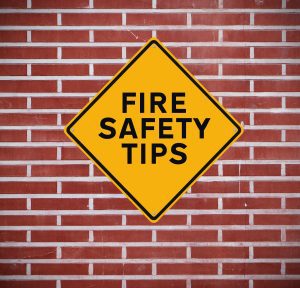Fire Safety Week is October 4 – October 10.
 Confession: I’m a low-key “prepper.” I put together a basement stash for tornado season, pack my car for winter weather emergencies, and now post-COVID, have a small stock of toilet paper and canned goods at the ready. Oddly, though, I’ve never put much thought into a fire safety plan. Perhaps it stems from misconceptions about how the majority of fires start. Our electrical is in good shape; we don’t use a wood-burning fireplace or space heaters. What do we have to worry about? As it turns out, cooking, which I do begrudgingly at least twice a day, is the most common cause of house fires. With that in mind, here are some things to consider to create a family fire safety plan.
Confession: I’m a low-key “prepper.” I put together a basement stash for tornado season, pack my car for winter weather emergencies, and now post-COVID, have a small stock of toilet paper and canned goods at the ready. Oddly, though, I’ve never put much thought into a fire safety plan. Perhaps it stems from misconceptions about how the majority of fires start. Our electrical is in good shape; we don’t use a wood-burning fireplace or space heaters. What do we have to worry about? As it turns out, cooking, which I do begrudgingly at least twice a day, is the most common cause of house fires. With that in mind, here are some things to consider to create a family fire safety plan.
Plan
In the event of a house fire, experts say there are only about two minutes to escape before it’s too late to get out, so it’s imperative to make the most of that time.
- Know the escape routes available from every room in the house, usually a door and a window.
- It might be helpful for families with older children to draw a floor plan of your house and mark the exit points together.
- Remember, if windows are an escape option, be sure they are accessible and easy to open.
- If you have vulnerable family members, assign a specific family member to help them escape. Both of my girls are too young to exit alone, so my spouse and I are each assigned to one of them.
- Also, consider putting pet safety decals on windows or doors to alert emergency crews to any pets that may still be in the home.
Smoke detectors
Working smoke detectors can add precious seconds to an escape. As part of your  safety plan, be able to locate every smoke detector in the house.
safety plan, be able to locate every smoke detector in the house.
- Experts suggest changing batteries and testing functionality twice a year. Like many families, I’ve found the spring and fall time changes to be an easy way to work this into our routine.
- Teach small children to know what the smoke alarms sound like and make sure everyone is prepared to exit the house immediately when they hear them.
Meet Up
- As a family, decide on an outside meeting place a safe distance from the front of the home where everyone will meet in the event of an emergency, and mark it on your escape plan. We live in a cul-de-sac, so our meeting place is in the median circle. Other examples could include a mailbox, neighbor’s front porch, or nearby stop sign.
- Call 911 from your safe location, never while still inside the house. And above all, do not go back into the house.
Practice
Lastly, a fire safety plan is only as good as your family’s ability to put it into action. Plan on practicing as a family at least twice a year and updating your plan as needed. For families with young children, experts recommend allowing them to master the plan during the day before considering a night-time drill and to let them know ahead of time so they can focus on the objective of practicing rather than being caught off guard and frightened.
For more fire safety tips and kid-friendly activities, check out the National Fire Prevention Association page.











